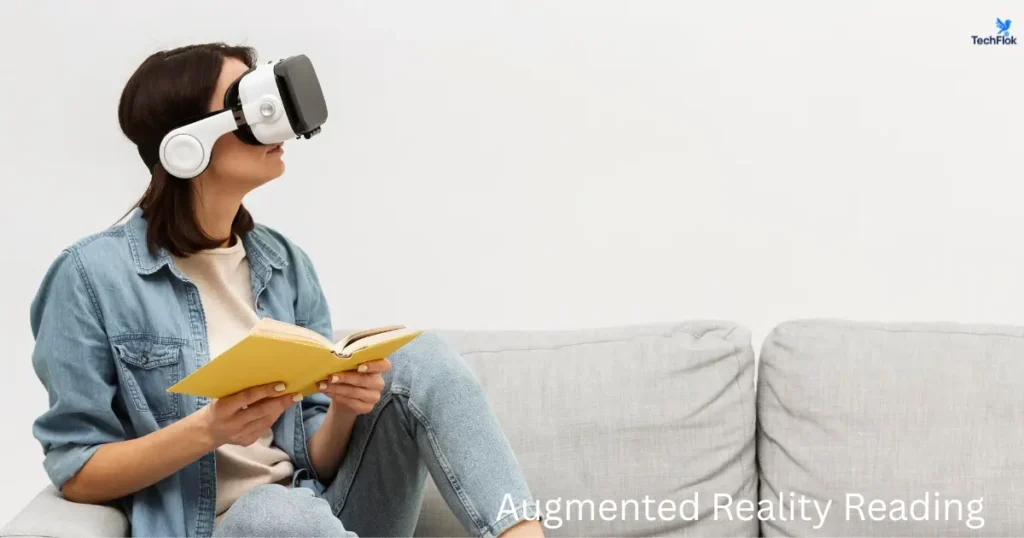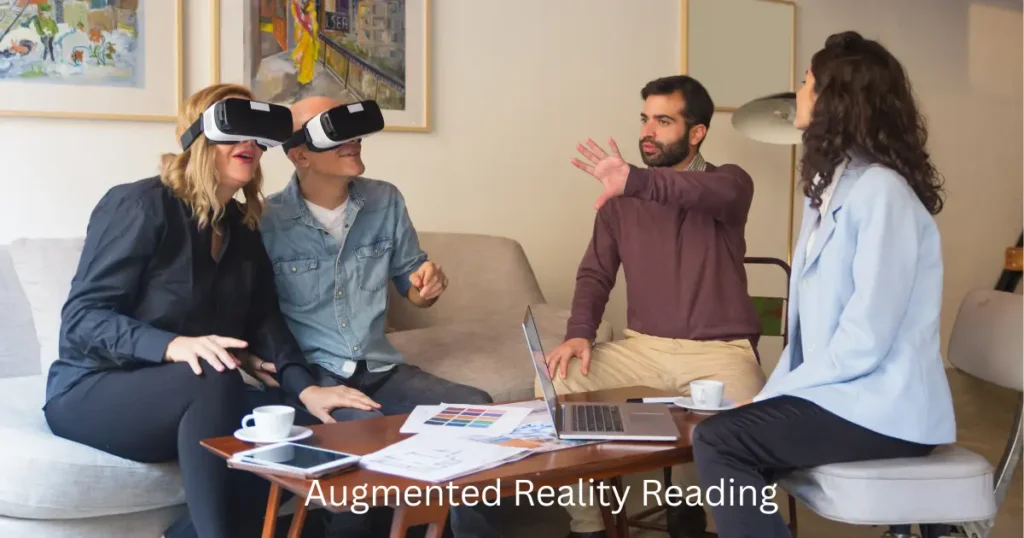
Augmented Reality Reading is a remarkabel inovation that combines real world reading with the digital world.Ever imagined a world where your book’s characters leap right off the page?
That’s augmented reality reading. It is a magical mix of the physical and digital worlds that’s transforming how kids, students, and even adults experience stories and learning. Whether you’re a teacher looking to spark engagement in class, a parent who wants your kids to enjoy reading again, or simply someone curious about how AR technology is changing education, this is where the future begins.
What Is Augmented Reality Reading?
Augmented Reality Reading, often called AR reading, is a new way of reading where printed or digital text interacts with virtual images, animations, and sounds. Using a phone, tablet, or even AR glasses, you can point your camera at a page and watch the story come to life characters move, objects appear in 3D, and voices start narrating the words.
This happens through AR apps that overlay digital content on the real world. You might recognize this idea from apps like Pokémon GO, where creatures appear in your surroundings. In reading, however, the goal is not just fun it’s about learning, retention, and engagement.
In short, augmented reality books transform a simple reading moment into an immersive experience where imagination meets interactivity.
How Does Augmented Reality Reading Work?
At its core, AR reading blends physical books and digital technology in a simple, fascinating way.
- Recognition: The AR app scans a marker, QR code, or image on the page.
- Activation: Once recognized, the app overlays interactive 3D models, videos, or audio that correspond to the text.
- Experience: The user can view, rotate, and even interact with these elements in real-time.
This process works through ARKit (for iOS) or ARCore (for Android), allowing your device’s camera and sensors to map the physical environment. The result is a reading experience that blends education and entertainment seamlessly.
For example, when you open a storybook about planets, the planets may appear orbiting right above your book. When reading about the human heart, a 3D beating heart can hover in front of you, teaching anatomy like never before.
Benefits of Augmented Reality Reading

Benefits of AR reading are backed by research and loved by teachers, parents, and students worldwide.
1. Improves Reading Comprehension
Reading comprehension increases when learners can visualize what they’re reading. Studies published on ScienceDirect show that when visuals and audio work together, the brain retains more information. Augmented reality reading turns abstract ideas into tangible experiences. For instance, a lesson about volcanoes becomes unforgettable when a 3D eruption plays out in front of your eyes.
2. Increases Motivation and Focus
Many teachers struggle with distracted readers. AR storybooks solve that by transforming reading into an active experience. Kids focus longer, interact more, and genuinely enjoy learning. The playful nature of interactive reading apps motivates even reluctant readers to participate.
3. Enhances Memory Retention
According to studies in educational psychology, students remember more when learning involves sight, sound, and touch. By combining all three, AR literacy tools make knowledge stick especially in STEM subjects like science, geography, and biology.
4. Supports All Types of Learners
Not everyone learns the same way. For visual learners, 3D models clarify complex topics. For auditory learners, narrations and sound cues help understanding. For kinesthetic learners, interacting with digital objects improves recall. That’s why augmented reality in education is now a core part of many modern classrooms.
5. Makes Learning Fun and Collaborative
AR reading apps turn solo reading into a social activity. Parents can explore books with children, and teachers can involve entire classrooms through AR smartboards or projectors. This mix of fun and collaboration increases not only learning outcomes but also emotional connection with reading.It is used by Medical Students for performing different tasks.
Real-World Examples of AR Reading
Let’s talk about where you can actually experience this magic.
- Bookful AR – A popular app that transforms traditional children’s stories into 3D adventures. Kids can see characters like Alice in Wonderland move and talk on their screens.
- QuiverVision – Allows students to color printed pages, scan them, and watch their drawings come alive. Perfect for creative and visual learners.
- Wonderscope – Lets children speak directly to story characters, blending reading and acting in one.
- OrCam Read – A life-changing AR reading device designed for people with visual impairments; it reads any printed text aloud.
- TIME Immersive – A project bringing journalism to life through AR storytelling, allowing users to experience history and science articles visually.
These examples prove that AR reading apps aren’t just for fun they serve education, accessibility, and creativity.
Augmented Reality Reading in Education
Teachers around the world are discovering that AR in classrooms boosts curiosity and participation. Imagine students learning about ancient Egypt while virtually walking through the pyramids, or reading a science chapter while interacting with a floating DNA strand.
With platforms like Merge EDU and PopAR, schools can integrate AR lesson plans into subjects like biology, geography, and literature. These interactive textbooks improve critical thinking, vocabulary, and conceptual understanding.
Even students in remote learning environments can benefit. Using WebAR tools, teachers can share interactive materials without needing special devices.
Simply put, augmented reality reading in education isn’t replacing traditional learning it’s enhancing it in the most human, engaging way possible.
Step-by-Step Guide for beginers
So how can you begin? It’s easier than you might think.
Step 1: Choose the Right Device
You can start with any smartphone or tablet that supports ARCore or ARKit. For the best experience, use a modern device with a good camera.
Step 2: Download an AR Reading App
Try apps like Bookful, Narrator AR, or AR Alphabet. Each has free and paid options depending on your reading level and goals.
Step 3: Get AR-Enabled Books
Purchase or download AR storybooks that work with your app. These books usually have a logo or QR code showing AR compatibility.
Step 4: Scan and Explore
Open the app, scan the page, and watch the animations appear. Tap the screen to interact, zoom, or listen to narrations.
Step 5: Use It for Learning
Parents can guide children to ask comprehension questions as they watch. Teachers can design classroom activities around these interactions to boost reading and writing skills.
Once you experience it, you’ll see that augmented reality reading is not just entertainment it is a new form of interactive education.
Challenges and Limitations of AR Reading
Like any technology, AR reading comes with challenges. Some apps need strong internet connections or modern devices to function smoothly. If you use older tablets, you may notice lag or camera calibration issues.
Additionally, experts suggest balancing screen time with traditional reading to protect children’s eyes and encourage imagination.
Another concern is quality control. Not all AR books are created equal. Always choose products from reliable educational publishers or verified app stores.
Still, as technology evolves, these challenges are quickly being solved, making AR literacy more accessible every year.
Future of Augmented Reality Reading
The next chapter in reading is going to be breathtaking. As devices become more powerful and AR glasses enter mainstream markets, reading will move beyond the page.
Imagine putting on your glasses and stepping inside the book itself. You could explore ancient cities, fly through space, or join a historical event all through immersive reading experiences.
Publishers are already experimenting with AI-driven AR books that adjust stories in real time based on user reactions. Soon, your favorite characters might respond to your voice or choices as you read.
The line between reading and experiencing will disappear and augmented reality storytelling will redefine education forever.
Conclusion
Augmented reality reading is not just a trend it’s the evolution of how humans connect with words, ideas, and imagination.
From improving reading comprehension to making classrooms more interactive, AR is rewriting the definition of literacy. Parents are discovering new ways to bond with their children, teachers are finding tools that spark engagement, and students are experiencing the joy of learning like never before.
If you haven’t tried it yet, now’s the perfect time. Download an AR reading app, grab an AR storybook, and let technology and creativity guide you through a whole new world of stories.
Reading will never feel the same again and honestly, that’s a good thing.
FAQs
What devices do I need for augmented reality reading?
You can use most modern smartphones or tablets that support ARCore (Android) or ARKit (iOS). Some high-end experiences also work with AR glasses.
Are AR books suitable for all ages?
Yes! There are AR storybooks for preschoolers, educational AR textbooks for students, and even immersive journalism apps for adults.
Does AR reading improve learning outcomes?
Studies show that AR-based learning enhances engagement, comprehension, and memory retention by activating multiple senses during reading.
Can AR reading help children with learning difficulties?
Absolutely. Many AR literacy apps are designed for visual or auditory learners and can help students with dyslexia or attention challenges.
Where can I find augmented reality books or apps?
You can explore apps like Bookful, PopAR, Merge EDU, or Amazon’s AR book section, where new titles are added regularly.


